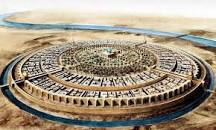

Adimchi
Walls of Benin
The Walls of Benin, also known as the Great Walls of Benin, were a series of defensive fortifications built in what is now present-day Nigeria. These walls are considered one of the most impressive feats of ancient engineering in Africa and one of the largest man-made structures in the world.
The Walls of Benin were built by the Edo people, who were the founders and rulers of the Benin Kingdom. The construction of these walls began in the 13th century and continued for several centuries. The walls were made of earth and were initially erected to protect the city of Benin and its people from invading armies. Over time, the walls were expanded and strengthened, and by the 15th century, they had become a formidable barrier that protected the kingdom from external threats.
The Walls of Benin were a complex system of fortifications that spanned over 6,000 kilometers (3,700 miles). They consisted of ramparts, moats, and bastions, and were built with incredible precision and attention to detail. The walls were constructed using a technique known as "rammed earth," which involved compressing layers of earth and clay between wooden frames to create a solid wall. The walls were then reinforced with layers of palm oil and palm fiber, which made them resistant to erosion and weathering.
The Walls of Benin were not just a defensive barrier; they also served as a symbol of the power and wealth of the Benin Kingdom. The walls were adorned with intricate carvings and artwork, including depictions of animals, people, and mythical creatures. The walls also served as a means of controlling trade and commerce in the region. The Benin Kingdom was a major center of trade in West Africa, and the walls helped to regulate the flow of goods and people in and out of the city.
Today, the Walls of Benin are a UNESCO World Heritage site and a testament to the ingenuity and engineering prowess of the Edo people. Although much of the wall has been lost over time due to neglect and urbanization, efforts are underway to preserve and protect what remains. The walls serve as a reminder of the rich cultural heritage of West Africa and the important role that the Benin Kingdom played in shaping the history of the region.
In conclusion, the Walls of Benin are a remarkable achievement of ancient engineering and a testament to the power and wealth of the Benin Kingdom. They were not only a defensive barrier but also served as a symbol of the kingdom's cultural and economic importance in the region. Today, they stand as a reminder of the ingenuity and resourcefulness of the Edo people and their remarkable contribution to the history of West Africa.